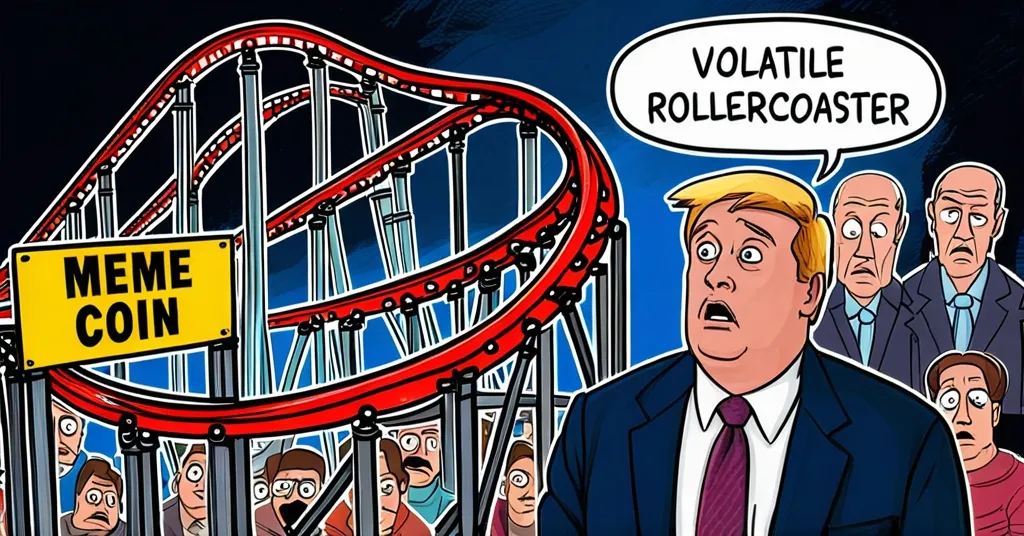Dave Portnoy’s $170K Fake LIBRA Blunder: Meme Coin Volatility and Crypto Community Skepticism

Dave Portnoy’s $170,000 LIBRA Blunder: Meme Coins, Mischief, and Market Mayhem
Dave Portnoy, a notable figure in the cryptocurrency sphere, recently claimed to have accidentally purchased a fake LIBRA coin worth $170,000. This faux pas quickly became a hot topic within the crypto community, especially since it wasn’t the controversial LIBRA token associated with Argentinian President Javier Milei, but a volatile meme coin.
- Portnoy’s $170,000 mistake with fake LIBRA coin
- Community doubts and grifting accusations
- Portnoy’s advisory role in original LIBRA token launch
Portnoy, ever the social media maestro, took to X to share the token’s contract address and issue a stark warning to potential investors. “Anybody wanna buy some fake Libra? Warning. This is a meme coin. I bought it by accident. It will be volatile. It will eventually go to zero. It may rip. It may tank. Don’t put on more than you can lose!!! It’s a collectible,” he posted. Meme coins, for those new to the crypto world, are cryptocurrencies inspired by internet memes and often rely on social media hype for their value.
Despite his caution, the fake LIBRA initially saw a dramatic 3000% surge in value, reaching a market cap (the total value of all the coins in circulation) of $27 million. However, the thrill was short-lived as the coin’s value crashed to a market cap of just $2.46 million, leaving Portnoy’s investment at a mere $50,000. This rollercoaster ride exemplifies the high volatility of meme coins, which can lead to substantial gains or losses.
The crypto community on X was quick to express skepticism. Accusations of Portnoy seeking “charity exit liquidity” flew, with one user stating, “Dudes basically asking for charity exit liquidity,” and another accusing him of trying to “grift off people who have less than you.” For context, “exit liquidity” refers to selling off an investment to minimize losses, and “grifting” implies deceitfully obtaining money from others.
The plot thickened with revelations of Portnoy’s earlier involvement with the original LIBRA token. He was set to be an advisor and had been gifted 6 million tokens, which he returned after being advised against disclosing the gift by Hayden Davis. Portnoy’s candor on X Space added to the intrigue, stating, “I’m not going to tweet about this f—ing launch and act like I’m just, ‘Oh, Milei’s the f—ing best’…and not mention that they have given me coins.”
The original LIBRA token, linked to President Javier Milei, had its own drama. Its market cap had soared to $4.5 billion before crashing, leading to a federal investigation in Argentina and calls for Milei’s impeachment over allegations of insider trading and market manipulation. Insider trading refers to trading based on non-public information, and market manipulation involves actions intended to deceive or mislead investors.
Hayden Davis, a key figure in the LIBRA project, defended insider deals in memecoin trading, arguing that criticism stems from those excluded from such deals. This perspective highlights the ethical considerations and motivations behind these projects. Meanwhile, experts like Andre Cronje of Sonic Labs and Samczsun of SEAL911 criticized the memecoin meta. Cronje emphasized that crypto should not be solely about extracting money, while Samczsun warned that the current trend could leave the industry in ruins.
This incident with the fake LIBRA coin and the original LIBRA token scandal underscores the volatile nature of meme coins and the risks they pose to investors. Influencer endorsements and insider trading can significantly manipulate market dynamics, often leaving others at a disadvantage. The political ramifications of the LIBRA token scandal in Argentina further illustrate the potential for cryptocurrency projects to intersect with political agendas, leading to regulatory scrutiny and public backlash.
While meme coins can bring fun and excitement to the crypto space, they also highlight the need for greater transparency and ethical considerations, especially when high-profile figures like Portnoy are involved. The drive towards decentralization and freedom in cryptocurrency is vital, but incidents like these remind us of the importance of staying vigilant against market manipulation and misinformation.
Key Takeaways and Questions
- What happened with Dave Portnoy and the fake LIBRA coin?
Dave Portnoy claimed to have accidentally bought a fake LIBRA coin worth $170,000, which he then shared on social media with warnings about its risks.
- How did the cryptocurrency community react to Portnoy’s claims?
The community expressed skepticism, with many believing that Portnoy’s actions were a ploy to exit his investment, and some accused him of grifting.
- What was Portnoy’s involvement in the original LIBRA token launch?
Portnoy was set to be an advisor for the original LIBRA token and had initially received 6 million tokens, which he later returned after advice against disclosing the gift.
- What are the potential risks associated with investing in meme coins like the fake LIBRA?
Meme coins are highly volatile and can experience significant price fluctuations, often leading to substantial losses for investors.
- How does this incident reflect broader issues in the cryptocurrency market?
It highlights the risks of misinformation, market manipulation, and the need for transparency, especially when high-profile individuals are involved in cryptocurrency projects.



